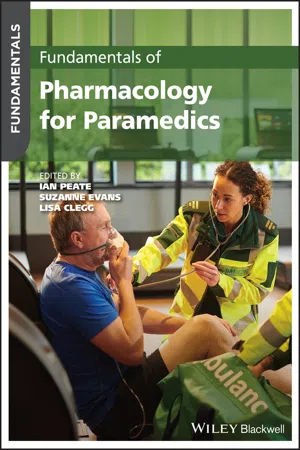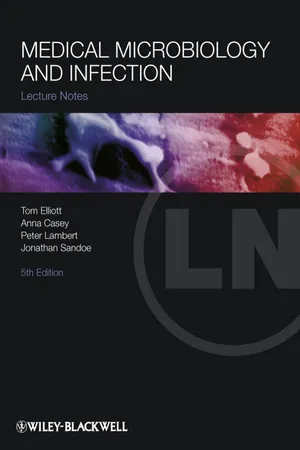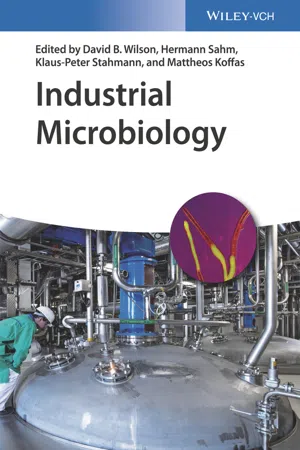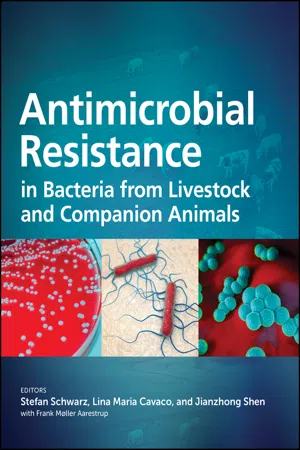Biological Sciences
Bactericidal Antibiotics
Bactericidal antibiotics are a class of antibiotics that have the ability to kill bacteria. Unlike bacteriostatic antibiotics, which only inhibit the growth and reproduction of bacteria, bactericidal antibiotics directly target and destroy bacterial cells. This makes them particularly effective in treating severe bacterial infections and in situations where a rapid reduction in bacterial population is necessary.
Written by Perlego with AI-assistance
Related key terms
6 Key excerpts on "Bactericidal Antibiotics"
- eBook - ePub
- José F. Jr Siqueira, Isabela N. Rôças(Authors)
- 2022(Publication Date)
- Quintessenz Verlag(Publisher)
Table 19-1 ). If these principles are not adhered to, the treatment will not work and undesirable side effects may occur.Mechanisms of antibacterial action
Some antibiotics kill bacteria (bactericidal) while others inhibit bacterial growth (bacteriostatic). Each type of antibiotic performs its effect through a specific mechanism of action (Table 19-2 ). Bactericidal Antibiotics kill bacteria, inhibiting cell wall synthesis (β-lactams, vancomycin, bacitracin, etc), disrupting the cytoplasmic membrane (polymyxins, polyenes, etc), or acting on DNA (metronidazole, quinolones). Bacteriostatic antibiotics, on the other hand, inhibit bacterial growth, inhibiting protein synthesis (aminoglycosides, chloramphenicol, macrolides, tetracyclines, lincosamides, etc) or exerting antimetabolite activity, e.g. by inhibiting folic acid synthesis (sulfonamides, trimethoprim, etc). While the distinction between bactericidal and bacteriostatic agents appears to be clear according to the in vitro definition, this only applies under strict laboratory conditions and is inconsistent for a particular agent against all bacteria.42 Bacteriostatic antibiotics can exhibit bactericidal effects at high concentrations. Although bacteriostatic/bactericidal data may provide valuable information on the potential action of antibacterial agents in vitro, it is necessary to combine this information with pharmacokinetic and pharmacodynamic data to provide a more meaningful prediction of efficacy in vivo. The ultimate guide to treatment of any infection must be clinical outcome.45β-lactam antibiotics (penicillins and cephalosporins), which are the most widely used antibiotics in the treatment of endodontic infections, kill bacteria by inhibiting cell wall synthesis. The action of β-lactams especially occurs during the active growth of the bacteria, at which time the bacterial cell wall is synthesized. β-lactams inhibit transpeptidases, which are the enzymes that catalyze the crosslinking of peptidoglycan molecules. Peptidoglycan crosslinking is essential for the bacterial cell wall to be rigid, and to protect the bacterium from osmotic lysis. β-lactams competitively inhibit transpeptidases by binding to these enzymes as alternative substrates. Transpeptidases act as penicillin-binding proteins (PBPs). In addition, the β-lactams–PBP complex stimulates the release of autolysins, which are enzymes that digest the existing cell wall. This results in the destruction of the cell wall and the death of the bacteria by osmotic lysis (cytolysis). - eBook - ePub
- Ian Peate, Suzanne Evans, Lisa Clegg, Ian Peate, Suzanne Evans, Lisa Clegg(Authors)
- 2022(Publication Date)
- Wiley-Blackwell(Publisher)
antibiotic are often used interchangeably, but each term has its own specific meaning. An antimicrobial is active against bacteria and/or other micro‐organisms including viruses, fungi and protozoa. An antibacterial is active against bacteria. An antibiotic is a drug that is produced by one type of micro‐organism to protect itself from another micro‐organism, and is therefore from natural sources. The more general terms antimicrobial and antibacterial can refer to drugs that are both natural and synthetic in origin.Selective toxicity is the ability of an antimicrobial to harm microbes without injuring human cells. Antimicrobials do this by a range of different mechanisms, many of which exploit differences of structure or function between microbial and human cells. However, when these differences are small, antimicrobial actions can cross over to human cell function and cause cell damage.The goal of antibacterial therapy is to either eliminate a bacterial infection or reduce the number of bacteria to a level which the immune system can effectively deal with. Antibacterial drugs can either be bactericidal, meaning they directly kill bacteria (e.g. penicillins and aminoglycosides), or bacteriostatic - eBook - ePub
Biotechnology of Lactic Acid Bacteria
Novel Applications
- Fernanda Mozzi, Rául R. Raya, Graciela M. Vignolo(Authors)
- 2015(Publication Date)
- Wiley-Blackwell(Publisher)
5.6. Future Perspectives
With the increasing development of resistance to classical antibiotics in recent years, there is an ever increasing need for novel antimicrobial agents, for medical, food, and feed industries. However, the search for new antibiotics is slow, as there are apparently fewer classes of antibiotics left to be discovered and cumbersome laws and regulations and large costs associated with research and development. Bacteriocins have many favorable characteristics that make them some of the most promising candidates for novel antimicrobials. First, most bacteriocins have relatively narrow inhibitory spectra that make it possible to target specific pathogens or unwanted bacteria. Consequently, the toxicity of bacteriocins to eukaryotic cells is generally low if present at all, especially at the concentrations required for antimicrobial activity. In contrast to most traditional antibiotics, which often act in micromolar concentrations, bacteriocins are commonly active in the nanomolar range, that is, displaying extremely high specific activity. Furthermore, it is possible that the activity of bacteriocins can be increased through combination with other antimicrobials or membrane-active substances. Some bacteriocins have broad antimicrobial spectra, and generally those produced by Gram (+) bacteria are broader than the Gram (+) producers. Broad spectrum antimicrobial agents can be useful for targeting infections of unknown origin. However, it has been established that use of broad spectrum antibiotics can have a negative impact on the commensal and beneficial human microbiota, and so the prospect of targeting specifically a pathogenic genus/species without adversely affecting the commensal population is highly appreciated. Importantly, the antimicrobial spectra of bacteriocins commonly include pathogenic and antibiotic resistant strains of Streptococcus, Staphylococcus, Enterococcus, Propioonibacterium, Listeria, and Clostridium, rendering possible numerous applications of such bacteriocins. Staphylococci and enterococci are responsible for a large number of nosocomial infections and instances where acquired resistance to antibiotics present a serious problem in medical treatment worldwide. The LAB bacteriocins have a special status, in that many of the bacteriocins as well as the producing strains are generally regarded as safe (GRAS) or Qualified Presumption of Safety (QPS), because they are produced by bacteria commonly found in fermented foods and in the human microbiota. Especially many species of Lactobacillus, Leuconostoc, and Pediococcus - Tom Elliott, Anna Casey, Peter A. Lambert, Jonathan Sandoe(Authors)
- 2012(Publication Date)
- Wiley-Blackwell(Publisher)
Part 2 Antimicrobial AgentsPassage contains an image Chapter 20 Antibacterial Agents Peter Lambert Aston University, Birmingham, UK
Definitions
Antimicrobial Agent
Substance with inhibitory properties against microorganisms, but with minimal effects on mammalian cells (includes antibiotics and synthetic compounds).Antibiotic
Substance produced by microorganisms that inhibits the growth of (bacteriostatic) or kills (bactericidal) other bacteria. The term ‘antibiotic’ is often incorrectly used to include all antimicrobial agents, some of which are synthetic, e.g. sulphonamides, trimethoprim, metronidazole and fluoroquinolones.Semi-Synthetic Antimicrobials
Antibiotics chemically altered to improve properties, e.g. stability, activity, spectrum of activity and pharmacokinetics.Mechanism of Action
How an antimicrobial exerts its effects.Interactions Between Antimicrobials
- Antimicrobials used in combination may be: additive : combined effect equal to the sum of the individual agents;
- Synergistic : combined effect greater than achieved with addition; e.g. gentamicin plus penicillin; or
- Antagonistic : drugs inhibit the action of each other.
Empirical Therapy
Refers to the antimicrobial regimen used when a clinical diagnosis of infection has been made and delay in initiating therapy to await microbiological results would be inappropriate. (e.g. cefotaxime for meningitis).Directed Therapy
Directed antimicrobial regimens are prescribed to target a specific pathogen (or pathogens), usually informed by the results of microbiological investigations (e.g. benzylpenicillin for a penicillin-susceptible pneumococcal pneumonia or flucloxacillin for a meticillin-susceptible S. aureus- eBook - ePub
- David B. Wilson, Hermann Sahm, Klaus-Peter Stahmann, Mattheos Koffas(Authors)
- 2019(Publication Date)
- Wiley-VCH(Publisher)
8 Antibiotics and Pharmacologically Active Compounds Lei Fang1 , Guojian Zhang1,2,3 , and Blaine A. Pfeifer1,2,3 1 University at Buffalo, The State University of New York, Department of Chemical and Biological Engineering, 904 Furnas Hall, Buffalo, NY, 14260‐4200, USA 2 Ocean University of China, Key Laboratory of Marine Drugs, Chinese Ministry of Education, School of Medicine and Pharmacy, Qingdao, 266003, People's Republic of China 3 Laboratory for Marine Drugs and Bioproducts of Qingdao National Laboratory for Marine Science and Technology, Qingdao, 266237, People's Republic of ChinaCHAPTER MENU
- 8.1 Microbial Substances Active Against Infectious Disease Agents or Affecting Human Cells
- 8.2 β‐Lactams
- 8.3 Lipopeptides
- 8.4 Macrolides
- 8.5 Tetracyclines
- 8.6 Aminoglycosides
- 8.7 Claviceps Alkaloids
- 8.8 Perspectives
8.1 Microbial Substances Active Against Infectious Disease Agents or Affecting Human Cells
8.1.1 Distribution and Impacts
Small molecule natural products have had a powerful impact on human health and follow‐up commercial development. In this chapter, a heavy emphasis will be placed on those small molecules that possess antibiotic activity, a capability that has particularly impacted modern medicine, in addition to alternative therapeutic activities associated with these same types of compounds. A common definition of an antibiotic (derived from “antibiosis,” which was first used by Vuillemin in 1889) is a chemical substance produced by a microorganism that can kill or inhibit the growth of other microorganisms. More broadly, an antibiotic may be any small molecule with antimicrobial activity. Microorganisms have developed metabolic pathways devoted to natural products that possess antibiotic activity. Such pathways are referred to as secondary metabolism, distinct from primary metabolism in that the final compounds (secondary metabolites) do not contribute to the primary growth and maintenance goals of the microbial cell. Many times, the terms “natural products” and “secondary metabolites” are used interchangeably, with the common feature being a small molecule (relative to macromolecules within the cell). The biological features of these compounds include antibiotic properties as a way to engage in a form of chemical warfare with competing microbes for limited nutrients in the environment. Once identified, the scientific community developed a pipeline for natural product production with the goal of redirecting the antibiotic properties toward clinical applications. The goal of this chapter is to give the reader an appreciation for the history, biosynthetic mechanisms, classification examples, engineering development, challenges, and future opportunities for this remarkable class of compounds. - Stefan Schwarz, Lina Maria Cavaco, Jianzhong Shen(Authors)
- 2018(Publication Date)
- ASM Press(Publisher)
4 Mechanisms of Bacterial Resistance to Antimicrobial Agents Engeline van Duijkeren, 1 Anne-Kathrin Schink, 2 Marilyn C. Roberts, 3 Yang Wang, 4 Stefan Schwarz 2 INTRODUCTION With regard to their structures and functions, antimicrobial agents represent a highly diverse group of low-molecular-weight substances which interfere with bacterial growth, resulting in either a timely limited growth inhibition (bacteriostatic effect) or the killing of the bacteria (bactericidal effect). For more than 60 years, antimicrobial agents have been used to control bacterial infections in humans, animals, and plants. Nowadays, antimicrobial agents are among the most frequently used therapeutics in human and veterinary medicine (1, 2). In the early days of antimicrobial chemotherapy, antimicrobial resistance was not considered as an important problem, since the numbers of resistant strains were low and a large number of new highly effective antimicrobial agents of different classes were detected. These early antimicrobial agents represented products of the metabolic pathways of soil bacteria (e.g., Streptomyces, Bacillus) or fungi (e.g., Penicillium, Cephalosporium, Pleurotus) (Table 1) and provided their producers with a selective advantage in the fight for resources and the colonization of ecological niches (3). This in turn forced the susceptible bacteria living in close contact with the antimicrobial producers to develop and/or refine mechanisms to circumvent the inhibitory effects of antimicrobial agents. As a consequence, the origins of bacterial resistance to antimicrobial agents can be assumed to be in a time long before the clinical use of these substances
Learn about this page
Index pages curate the most relevant extracts from our library of academic textbooks. They’ve been created using an in-house natural language model (NLM), each adding context and meaning to key research topics.





